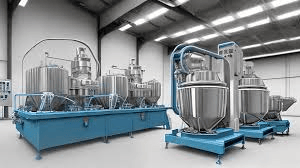
The granulation process ensures that fine powders are converted into uniform granules, improving flowability, compressibility, and consistency in manufacturing. Among the various factors that influence granulation quality, mixing speed and time are two of the most critical parameters. This article delves deep into the importance of mixing speed and time in a Rapid Mixer Granulator, exploring their impact on granule properties, process efficiency, and final product quality.
Understanding the Rapid Mixer Granulator (RMG)
A Rapid Mixer Granulator consists of three main components:
-
Impeller: Responsible for mixing and breaking down agglomerates.
-
Chopper: Helps in size reduction and uniform distribution.
-
Bowl: Where the entire mixing and granulation process takes place.
The operation of an RMG is based on a combination of mixing, wet massing, and granulation, where powders are blended at high speeds, and a binding liquid is added to form granules. The Rapid Mixer Granulator efficiency of this process is largely dependent on mixing speed and time.
The Role of Mixing Speed in Rapid Mixer Granulation
Mixing speed in an RMG directly influences the granulation outcome. It affects:
-
Granule Size and Uniformity: Higher speeds lead to finer granules, while lower speeds produce coarser granules.
-
Binding Liquid Distribution: An optimal mixing speed ensures uniform spreading of the granulation liquid.
-
Porosity and Density: The right speed ensures consistent density and porosity, essential for tablet compression.
Optimal Mixing Speed for Granulation
Finding the right balance is crucial, as excessive speed can lead to overgranulation, while insufficient speed may result in inadequate mixing.
-
Low Mixing Speed (50-150 rpm): Used for initial blending of powders.
-
Medium Mixing Speed (150-300 rpm): Optimal for wet massing and uniform distribution of liquid binder.
-
High Mixing Speed (300-500 rpm): Used in the final stages for rapid granule formation.
The Importance of Mixing Time
Mixing time determines the extent to which ingredients blend and form granules.
-
Short Mixing Time: Leads to insufficient granule formation and poor flowability.
-
Excessive Mixing Time: Results in dense granules, leading to hardness issues in tablets.
Optimal Mixing Time for Different Granulation Stages
-
Dry Mixing Stage (1-5 minutes): Ensures uniform distribution of excipients.
-
Wet Massing Stage (5-10 minutes): Binds particles together into granules.
-
Final Granulation Stage (3-7 minutes): Adjusts size and uniformity of granules.
Interplay Between Mixing Speed and Time
The combined effect of mixing speed and time determines the final granule characteristics. A well-balanced approach ensures:
-
Consistent Granule Size
-
Proper Binder Distribution
-
Reduced Granule Breakage
Challenges in Setting the Right Mixing Speed and Time
Despite their importance, setting the correct mixing parameters comes with challenges:
-
Powder Flow Variability: Different excipients have varying flow properties.
-
Moisture Content: Affects binding efficiency.
-
Machine Variability: Different RMG models have varying specifications.
Strategies for Optimizing Mixing Speed and Time
-
Conducting Trial Batches: Helps in determining the best settings.
-
Using Process Analytical Technology (PAT): Real-time monitoring ensures precision.
-
Validating and Standardizing Processes: Ensures reproducibility across batches.
Conclusion
Mixing speed and time in a Rapid Mixer Granulator play a pivotal role in ensuring high-quality granules suitable for downstream processing. An optimized balance between these parameters enhances granule uniformity, compressibility, and tablet consistency. Understanding and fine-tuning these factors can significantly improve pharmaceutical and industrial granulation outcomes.





Leave a Reply